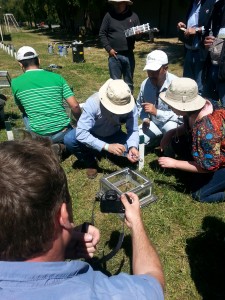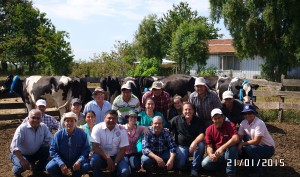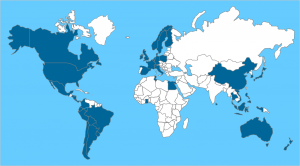Co-hosted by the Ministry of Agriculture and Cooperatives (MoAC) of Thailand in Bangkok, the GRA organized a regional meeting to start a network on farming systems. Participating countries were Indonesia, Korea, Malaysia, Myanmar, Philippines, Vietnam and of course Thailand. With the support of Agriterra, farmer representatives from the Philippines and Indonesia also joined this meeting. The Netherlands, the current Chair of the GRA, was represented by the Co-chair of the GRA Inventory and Monitoring (I&M) Group and a policy official of the Dutch Ministry of Economic Affairs. In this two-day workshop, the countries’ policy and research representatives explored the challenges and difficulties of developing farming systems that meet the impact of a changing climate. On the first day the exchange of experiences between participants was the focus. On the second day, participants analyzed the exchanged information and identified common areas of interest. As a result they identified and agreed to put their efforts into four projects. The projects are: 1) Mixed farming systems, 2) Knowledge transfer/adoption of mitigation technologies/adaptations for GHG reduction, 3) Development of information systems for tools and technologies, and 4) Increased collaboration between policy makers, researchers and farmers. For each project, one (or two) leading countries will initiate the process. This very successful workshop makes an impressive start to the regional collaboration initiated and supported by the GRA. In the upcoming months the groups will exchange the results, and as the process continues it will be worthwhile to meet again in a year’s time.
Akarapon Houbcharaun, Thailand: [email protected] / Jan Verhagen, the Netherlands: [email protected]
A position (up to 2.5 years) is available for a postdoctoral fellow who will be responsible for measuring nitrous oxide fluxes from grazed pastures systems based at the University of Waikato, Hamilton, New Zealand. The project will be purchasing equipment that allows eddy covariance measurements of nitrous oxide and the successful candidate will help install and maintain the equipment, collect data, interpret and write papers in this newly-developing field of research. The successful applicant will be part of a team measuring carbon dioxide and water fluxes from pastures and wetlands. The team’s goal is to find management practices that decrease the greenhouse gas burden on the atmosphere while maintaining production. Further details about the team and its research can be found on www.waiber.com. The full position description can be viewed at the University of Waikato, vacancy page: www.jobs.waikato.ac.nz, where applications should also be made. Enquiries of an academic nature should be directed to Professor Louis Schipper, email: [email protected].
The New Zealand Livestock Emissions and Abatement Research Network (LEARN) provides training and research opportunities throughout the year to support developing countries in New Zealand. The LEARN Technician Award provides funds for up to 6 months to train a qualified or experienced technician from a developing country in agricultural GHG emissions measurement techniques. The LEARN Co-Funded PhD provides a maximum 3-year stipend for a co-funded PhD candidate researching livestock GHG emissions mitigation. The LEARN Postdoctoral Fellow provides a recent PhD graduate with 1-2 years’ funding in livestock GHG emissions mitigation research.
For GRA Member countries, the LEARN Global Research Alliance Senior Scientist (GRASS) Award provides 6 weeks-6months’ funds for extended exchanges between NZ scientists and scientists from other Alliance member countries in accordance with the mission and objectives of LEARN and the GRA.
All posts are held in New Zealand. Application forms are assessed on a quarterly basis, with the next round closing April 30th.
More information at http://www.livestockemissions.net/
 The GRA kick-started 2015 with representatives from ten countries meeting to learn more about the quantification of greenhouse emissions in grazing systems. The meeting, hosted by Chile, involved twelve days of hands-on workshops, alongside lectures and case studies, in the city of Osorno. Workshops included topics such as static chambers construction and sampling, gas chromatography analysis, canister sampling and work with animals.
The GRA kick-started 2015 with representatives from ten countries meeting to learn more about the quantification of greenhouse emissions in grazing systems. The meeting, hosted by Chile, involved twelve days of hands-on workshops, alongside lectures and case studies, in the city of Osorno. Workshops included topics such as static chambers construction and sampling, gas chromatography analysis, canister sampling and work with animals.
The event is a second project that follows the successful four-year partnership project funded by New Zealand and the Inter-American Development Bank (IDB) Regional Fund for Agricultural Technology (FONTAGRO). This partnership project was designed to assist Latin American countries in improving their national greenhouse gas inventories and developing mitigation options adapted to their farming conditions. The 2015 project has expanded to include other countries, and continues to be funded by New Zealand and FONTAGRO.
 The 2015 participating countries were Bolivia, Colombia, Costa Rica, Ecuador, Honduras, Mexico, Nicaragua, Panama, Paraguay and Peru. Host Chile was one of the five countries (Argentina, Chile, Colombia, Dominican Republic, Uruguay) involved in the first project.
The 2015 participating countries were Bolivia, Colombia, Costa Rica, Ecuador, Honduras, Mexico, Nicaragua, Panama, Paraguay and Peru. Host Chile was one of the five countries (Argentina, Chile, Colombia, Dominican Republic, Uruguay) involved in the first project.
New discoveries on the greenhouse gas methane produced in the rumen of ruminant animals have been made through research funded by the New Zealand government to support the GRA. The research is part of the Global Rumen Census, the Hungate 1000 and the Identification of low methane emitting phenotypes research projects. NZ AgResearch has identified and classified methanogens in the rumen of New Zealand ruminant animals, to help pinpoint targets and develop strategies for reducing agricultural methane emissions. Findings to date show a limited diversity of methanogens, and in low-emitting rumens, a smaller physical size and additional strains of bacteria, some of which do not produce hydrogen. Another type of low-emitting rumen has been discovered and is still being examined. The findings represent an important step towards the goal of breeding low methane-emitting sheep which also maintain reproductivity and meat and wool production.
The Livestock Research Group of the Global Research Alliance on Agricultural Greenhouse Gases and Sustainable Agriculture Initiative Platform have joined forces to compile information about greenhouse gas mitigation options currently available, and a roadmap of emerging options based on current research, to help make progress on meeting global food demand while reducing the food industry’s contribution to global climate change.
Learn more about this collaboration from the LRG webpage.
The latest version of the Livestock Research Group Newsletter is now available to download.
This edition covers LRG activities in Africa; including a training course for participants from across Africa to learn about greenhouse gas measurement techniques, held at the University of Pretoria in South Africa, and a GRA side event alongside a Regional Universities Forum for Capacity Building in Agriculture (RUFORM) meeting in Mozambique. The Newsletter also provides an update on the manure management collaboration with the Climate and Clean Air Coalition (CCAC).
See previous editions of the LRG Newsletter.
Brandon University Rural Development Institute (RDI) is holding a webinar on the 12th of November, 2014. The webinar will specifically talk about Agriculture and Greenhouse Gases. For more information see the flyer for the event here.
In September the Livestock Research Group of the GRA held a two week training course to increase research capacity in methane and nitrous oxide measurements across Africa. The workshop was held at the University of Pretoria, South Africa.
We are proud to announce Tunisia has joined the Alliance as the 43rd member. We look forward to working with Tunisia in a number of areas.
The Basque Centre for Climate Change (BC3) is currently seeking an exceptional candidate with large experience on Climate Change research to undertake the position of Scientific Director.
The BC3 – Basque Centre for Climate Change is a Research Centre based in Bilbao which aims to contribute to long term research on the causes and consequences of climate change in order to foster the creation of knowledge in this multidisciplinary science. This center is part of the network of BERCs – Basque Excellence Research Centers supported by the Basque Government.
For more information on this job opportunity visit: http://www.bc3research.org/join_us/job_offers.html

